May 28, 2024 By Bilal Arshad 12 minutes read

Peristaltic pumps are important in many industries, like medical, pharmaceutical, and manufacturing, because of how they work and their flexibility. They can move fluids without contaminating them, making them perfect for jobs needing high purity and accurate fluid handling. Whether delivering IV fluids in hospitals or transferring harsh chemicals in factories, peristaltic pumps ensure efficient and clean fluid movement.
A peristaltic pump is a type of positive displacement pump that operates by squeezing and releasing a flexible tube or hose to move fluids. It uses the principle of peristalsis, which is the rhythmic contraction and relaxation of muscles to propel substances through a tube-like structure, such as the intestines in our digestive system.

A peristaltic pump operates on the principle of peristalsis, a process that mimics the natural rhythmic contraction and relaxation of muscles.
The basic concept of a peristaltic pump involves the use of rotating rollers or pads that compress and release the tubing, creating a squeezing action that propels the fluid from the inlet to the outlet.
The fluid is contained within the tubing, and there is no direct contact between the fluid and the pump components, ensuring contamination-free operation.
The development of peristaltic pumps can be traced back to the mid-19th century. Rufus Porter and J. D. Bradley invented the peristaltic pump in 1855 as a well pump and Eugene Allen in 1881 for blood transfusions.
These early designs laid the foundation for the modern peristaltic pump. Over the years, there have been significant advancements in peristaltic pump technology.
One area of advancement is in tubing technology, which has seen improvements in terms of pressure, life, and chemical compatibility. These advancements have led to higher flow rate ranges and eroded some of the advantages that roller pumps had over peristaltic pumps,
Tube pumps are a common type of peristaltic pump. They consist of a long, flexible tube that fits inside a circular pump casing. As rollers or shoes compress the tube in a rotating action, fluid is pushed through.
The tube’s elastic nature allows it to regain its shape, creating suction at the pump inlet and pushing the fluid out through the outlet.
Tube pumps are particularly useful in laboratories and medical settings where precision and contamination prevention are critical.
They offer excellent accuracy for dosing or transferring small volumes of fluid. Additionally, since the fluid only contacts the inside of the tube, the risk of contamination is minimal, making tube pumps ideal for sterile applications.
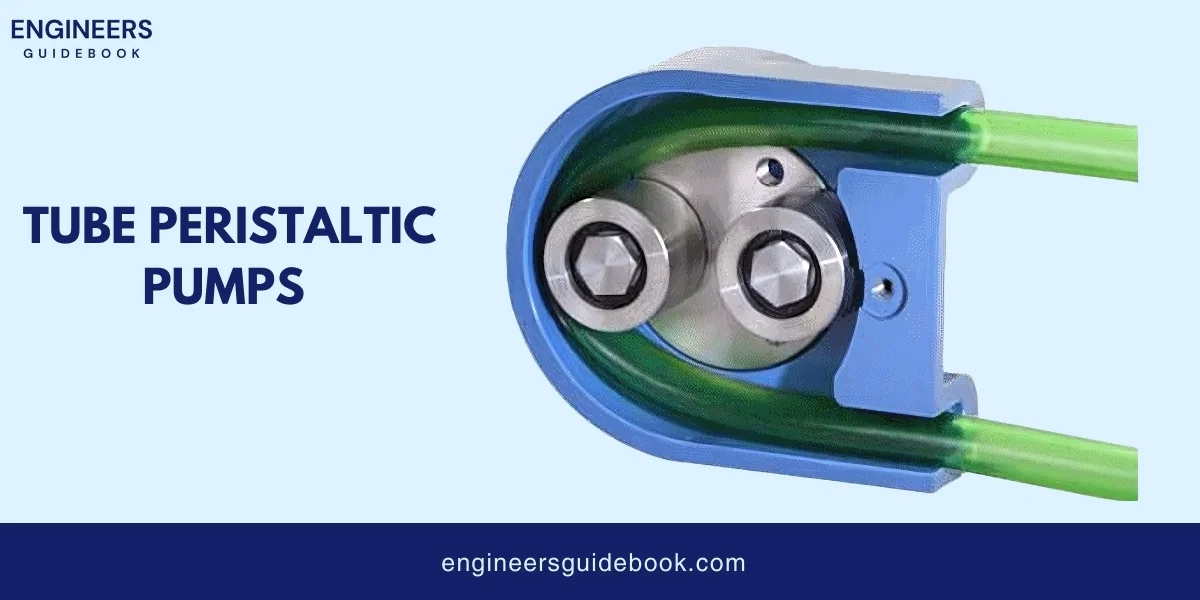
Hose pumps are similar to tube pumps but are designed to handle higher pressures. Instead of a thin, flexible tube, they use a robust, reinforced hose capable of enduring the stress of being compressed repeatedly by rollers. This design allows hose pumps to move thicker fluids over longer distances and at higher pressures.
Hose pumps are suited for industrial applications such as mining, wastewater treatment, and chemical manufacturing. They can pump abrasive, corrosive, and viscous substances without suffering the wear and tear those other types of pumps might experience.
The durability and robustness of hose pumps reduce maintenance needs and increase reliability in harsh environments.
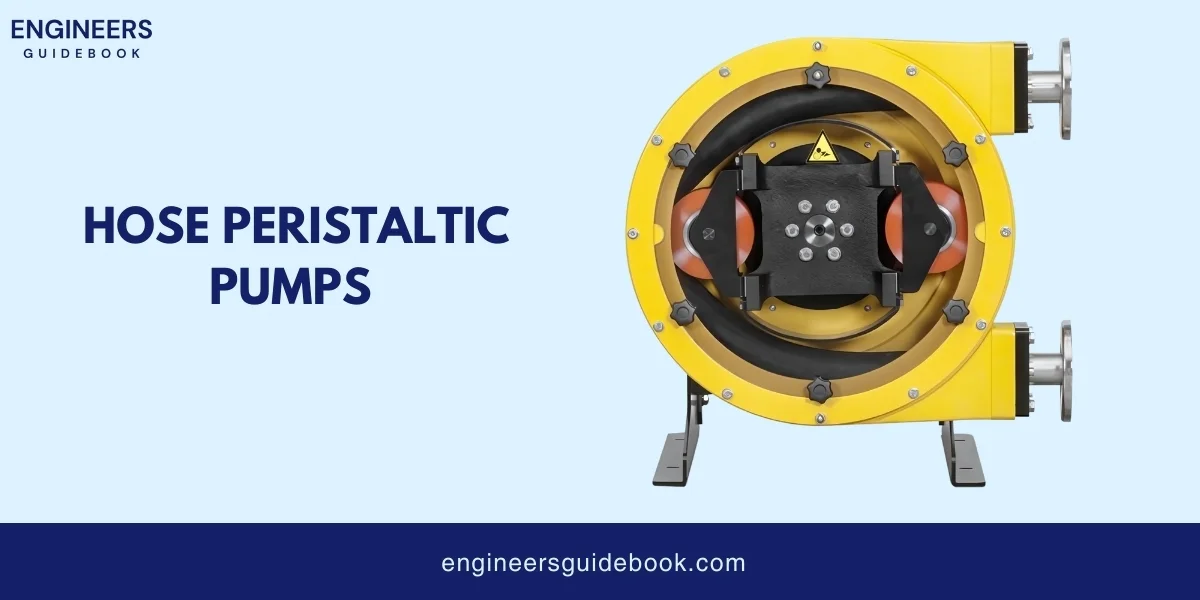
Peristaltic pumps consist of several key components that work together to move fluids efficiently. Here’s a breakdown of the essential parts:
The pump head houses the peristaltic pump’s moving parts. It typically includes the rollers or shoes that compress the tubing, the track or rotor on which these rollers move, and often a cover that keeps everything contained and clean.
Tubing is the core part of a peristaltic pump. It’s made from a flexible, durable material such as silicone or Tygon that can withstand repeated compression and relaxation.
The tubing’s quality and material directly affect the pump’s efficiency and the cleanliness of the fluid being pumped.
These components are critical in physically moving the fluid. Rollers or shoes press against the tubing, flattening it to push the fluid within.
The design and material of the rollers or shoes can significantly affect the lifespan of the tubing and the overall efficiency of the pump.
The motor drives the rollers or shoes around the pump head. Motors can vary widely in power and speed settings, depending on the pump’s intended use. Some peristaltic pumps also include speed controls to adjust the flow rate of the fluid being transferred.
Housing protects the internal components of the pump from external elements and contamination. It also provides structural support and optimizes the motor and pump head.
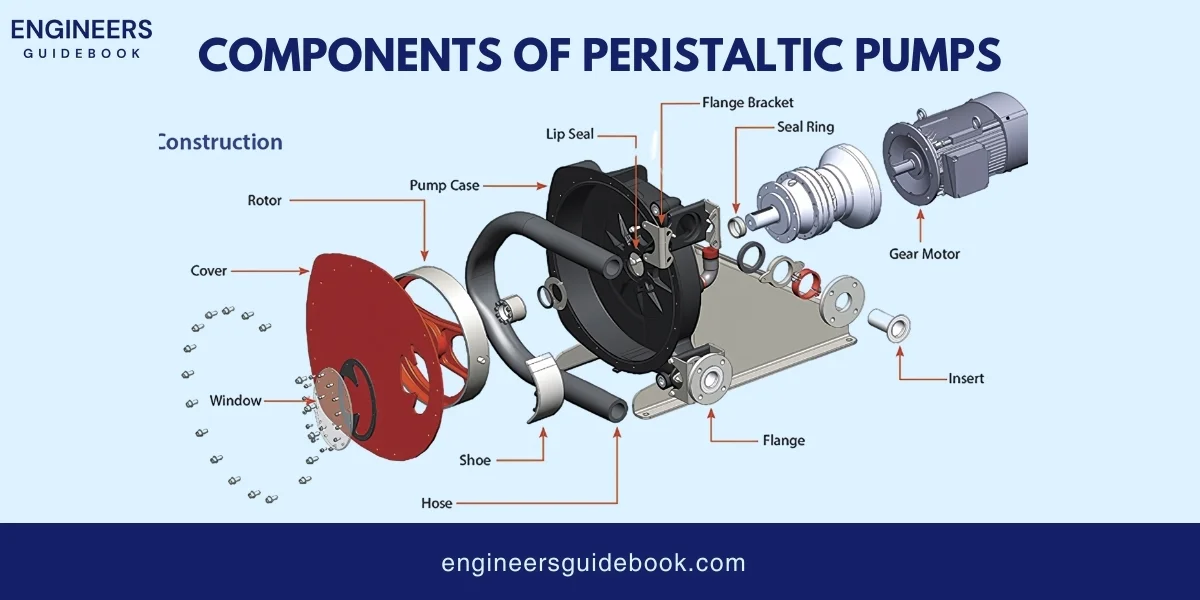
Peristaltic pumps operate on a straightforward but effective mechanism to move fluids. Below is a detailed explanation of this process, which can help in understanding how these devices function in various applications.
1. Compression: As the motor begins to turn, it moves rollers or shoes along a track inside the pump head. These rollers press against flexible tubing that is looped within the pump head, compressing it.
2. Sealing: When a roller compresses the tube, it seals off a section of the tube containing the fluid. This creates a closed pocket of fluid in that section.
3. Displacement: As the roller continues to move, it pushes this sealed pocket of fluid along the tube. The movement is similar to squeezing toothpaste from a tube; the area behind the roller is closed, and the fluid in front is pushed forward.
4. Suction: Behind the roller, as the tube regains its shape (due to its elasticity), it creates a vacuum that draws more fluid into the tube. This action ensures a continuous intake of fluid to be transported.
5. Output: The process of sealing, displacement, and suction continues with each rotation of the rollers, creating a steady flow of fluid out of the pump.
Gentle Pumping Action: Peristaltic pumps are known for their gentle handling of the fluids they pump. The design allows the fluid to move without ever being exposed to shear forces or aggressive mixing.
Self-Priming Capability: This means they can start pumping fluid without needing a head of fluid or manual priming.
Ability to Handle Aggressive Fluids: Peristaltic pumps can handle corrosive, abrasive, or viscous fluids with ease.
Contamination-Free Operation: Since the fluid pathway in a peristaltic pump is completely contained within the tubing, there is no risk of the fluid being contaminated by external elements.
Easy Maintenance: The maintenance of peristaltic pumps is relatively straightforward. The primary maintenance task is replacing the tubing, which can be done quickly and does not require specialized skills.
Limited Pressure and Flow Rates: Peristaltic pumps can handle only a certain level of pressure and have limits on how much fluid they can move at a time.
Tubing Wear and Tear: The tubes in peristaltic pumps can wear out over time because they are constantly being squeezed and released. This wear and tear mean the tubes need to be checked and replaced regularly.
Pulsating Flow: The flow of liquid from a peristaltic pump isn’t always steady. Instead, it can be pulsating,
Temperature Sensitivity: Peristaltic pumps are not very good at handling very hot fluids. High temperatures can damage the tubing, limiting the types of fluids these pumps can work with without risking damage to the system.
High Initial Costs: Compared to other types of pumps, peristaltic pumps can be more expensive to buy initially.
Pharmaceutical Industry: Peristaltic pumps are perfect for the pharmaceutical industry because they can pump fluids without contaminating them. They offer precise control over how much fluid is pumped, which is crucial for making medicines.
Food and Beverage Industry: In the food and beverage industry, keeping ingredients safe and clean during processing is essential. Peristaltic pumps are great for this because they can transfer ingredients hygienically.
Chemical Industry: They can manage corrosive or abrasive chemicals because the fluid only touches the tube, not the pump itself.
Water and Wastewater Treatment: In water treatment, peristaltic pumps help add chemicals accurately to treat water.
Mining: Peristaltic pumps are used To handle abrasive and thick fluids found in mining processes.
Paint and Coatings: These are useful for transferring various types of paints and coatings, maintaining their quality without air bubbles.
Laboratory Applications: Ideal for experiments that require precise dosing and contamination-free conditions.
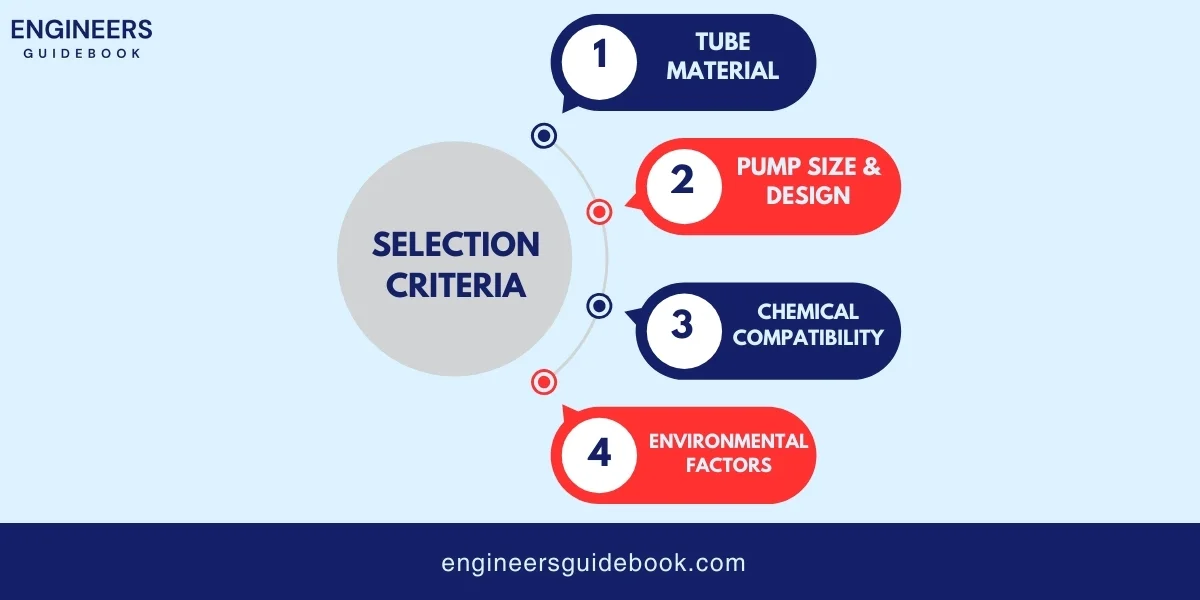
The material of the tube inside a peristaltic pump is crucial. It must be flexible enough to compress and release smoothly and durable sufficient to handle the wear from constant squeezing.
The size of the pump and its overall design should match the specific needs of its application. For instance, larger pumps are needed for higher flow rates, while compact pumps are suitable for smaller, more precise tasks.
Please ensure the pump’s materials, especially the tubing, are compatible with the chemicals it will be exposed to. This prevents the tube from deteriorating, which could cause leaks.
Think about the environment where the pump will be used. For instance, if it’s in a place with extreme temperatures or where explosive materials are handled, the pump’s design must accommodate these conditions to operate safely and effectively.
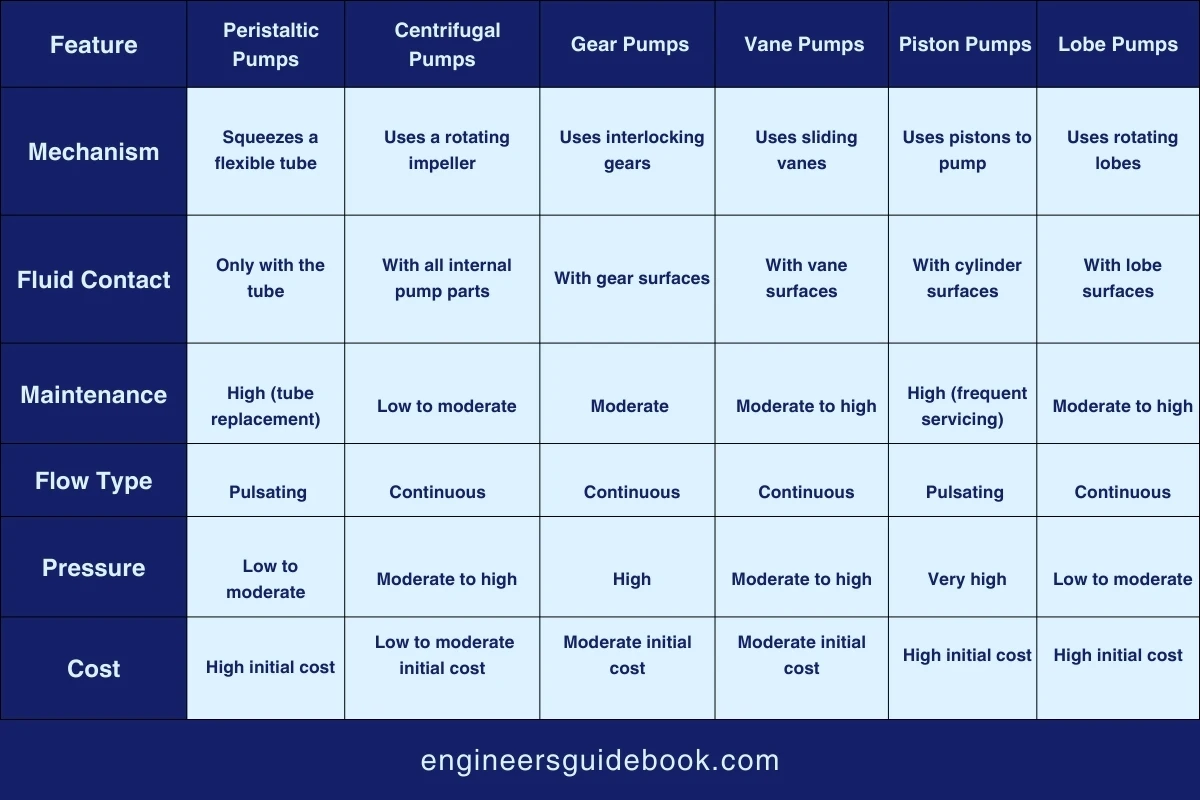
Signs of Wear: Look for cracks, stiffness, or thinning in the tubing, which indicates it’s time to replace it.
Best Practices: Regularly check the tubing’s condition and replace it before it fails to prevent downtime. Keeping a maintenance schedule can help manage timely replacements.
Troubleshooting: If the pump flow becomes inconsistent, check for blockages in the tubing or issues with the pump settings.
Adjusting for Consistent Flow: Ensure the pump speed and pressure settings are correctly adjusted according to the fluid’s viscosity and required flow rate. Regular calibration may be needed to maintain accuracy.
Identifying Causes: Common causes of leaks include worn-out tubing, loose connections, or damaged pump heads.
Implementing Fixes: Regularly inspect the pump and connections for any signs of wear or damage. Replace any faulty parts immediately and ensure all connections are tight and secure.
Maintenance Tips: To reduce wear, keep the rollers and housing clean and free from debris. Lubricate moving parts if recommended by the manufacturer.
Prolonging Lifespan: Use the pump within its specified operational limits to avoid excessive wear. Replace worn rollers and housing components as needed to extend the overall lifespan of the pump.
Techniques: To minimize flow pulsation, consider using a pulsation damper on the discharge side of the pump. This device can smooth out the pulsing nature of the flow, making it steadier.
A leading pharmaceutical company faced challenges with its traditional diaphragm pumps, often leading to contamination risks due to seal failures. To mitigate this, they implemented peristaltic pumps for transferring sensitive liquid medications.
A food and beverage manufacturer faced issues with their existing pumps, which caused inconsistent flow rates and product wastage. Switching to peristaltic pumps helped achieve a smoother, more controlled flow of ingredients and final products.
Peristaltic pumps have proven highly versatile and practical across various industries, addressing specific challenges and enhancing operational efficiency. In the pharmaceutical sector, they ensured aseptic conditions, reduced contamination risks, and cut costs. Wastewater treatment plants benefited from their ability to handle abrasive materials without clogging, leading to reduced maintenance and energy savings.
In the food and beverage industry, peristaltic pumps achieve consistent flow rates, minimize product wastage, and meet stringent food safety regulations. These advantages highlight the significant impact of choosing the right pumping technology for industry-specific needs.
Overall, the case studies demonstrate that peristaltic pumps are a reliable and efficient solution, offering substantial benefits in efficiency, cost reduction, and performance enhancement. Adopting advanced technologies like peristaltic pumps will be crucial for driving innovation and achieving operational excellence as industries evolve.
Peristaltic pumps operate by compressing and decompressing a flexible tube or hose using rotating rollers or shoes.
This action pushes the fluid through the pump, ensuring it only contacts the tubing, which helps maintain sterility and prevent contamination.
Peristaltic pumps are widely used in pharmaceuticals, wastewater treatment, food and beverage processing, chemical processing, and biotechnology due to their ability to handle various fluids and maintain cleanliness.
Yes, peristaltic pumps can handle high-pressure applications, with some models capable of managing pressures up to 15 bar (217 psi) when equipped with suitable high-pressure tubing.
Advantages include contamination-free pumping, self-priming capabilities, the ability to handle viscous and abrasive fluids, minimal maintenance, suitability for dry running, and gentle pumping action ideal for shear-sensitive materials.
Peristaltic pumps are devices that use a series of rollers or chambers to move fluids through a tube. They work by creating a wave-like motion that pushes the fluid forward, similar to how the muscles in your digestive system move food through your body.
Selection involves considering fluid compatibility, desired flow rate and pressure, tubing size and material, pump configuration (fixed or variable speed), and control and monitoring features to meet specific operational requirements.
Peristaltic pumps can handle various fluids, including viscous, abrasive, corrosive, and shear-sensitive fluids. They are also suitable for fluids containing solids and are commonly used for chemicals, slurries, and biological materials.
Peristaltic pumps are suitable for both continuous and intermittent operations, providing versatility for different industrial applications with precise control of flow rates and dispensing volumes.
Maintenance includes periodic tubing inspections for wear and tear, regular tube replacement, cleaning to prevent contamination, lubrication as needed, and calibration to ensure accurate flow rates.
Yes, peristaltic pumps can run dry without damaging the pump, although it is generally recommended to avoid extended dry running to prevent premature wear on the tubing.
Performance can be affected by tubing size and material, tubing condition, roller speed, back pressure, fluid viscosity, temperature, and overall system configuration.
Common issues can be troubleshooted by checking for tubing wear or failure, ensuring proper priming, inspecting for air leaks, verifying roller and shoe conditions, and confirming that the pump is not clogged with debris.
The lifespan of a peristaltic pump hose or tube depends on the chemical compatibility, abrasiveness, and operating conditions. Regular inspections and timely replacements are essential to maintain optimal performance.
Peristaltic pumps are generally more suitable for handling abrasive and shear-sensitive fluids and are easier to maintain due to the absence of seals and valves. Diaphragm pumps, however, might be preferred for higher pressure and more aggressive chemical applications.
The maximum flow rate and pressure for peristaltic pumps vary by model, with flow rates ranging from as low as 0.0005 mL/min to 42 LPM and pressure capabilities up to 15 bar (217 psi) for high-pressure models.

Bilal Arshad, with a PhD in Mechanical Engineering from Caltech, specializes in robotics and automation. His cutting-edge research in autonomous systems is revolutionizing industrial manufacturing processes.
Explore the Engineer’s Guidebook! Find the latest engineering tips, industry insights, and creative projects. Get inspired and fuel your passion for engineering.
© 2023-2024 Engineer’s Guidebook. All rights reserved. Explore, Innovate, Engineer.
3 Responses
very good article on this type of pump. not much information on this topic on google. your information is very good and easy to understand.
Hmm is anyone else experiencing problems with the images on this blog loading? I’m trying to figure out if its a problem on my end or if it’s the blog. Any responses would be greatly appreciated.
I am always looking online for posts that can aid me. Thanks!